The Parrot Society UK
The Scarlet Macaw in Costa Rica - Dr Chris Vaughan
The Scarlet Macaw (Ara Macao) in Costa Rica
An Environmental Education Project
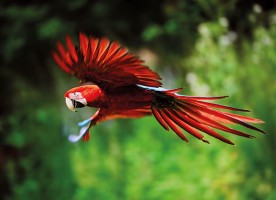
Scarlet Macaw in flight (PSUK stock image)
This project has been part-funded from the PSUK Conservation Fund for several years now, with regular reports received from Dr Chris Vaughan published in our magazines. Money has been used to help publish colouring books illustrating these birds for local school children, as well as the construction of nest boxes and the installation of nest-box cameras.
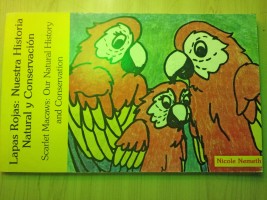
Colouring book produced for schoolchildren to stimulate interest in the project (Photo: Dr Chris Vaughan)
Dr Vaughan reported in our magazine of July 2017 that "Scarlet Macaw numbers are in danger due to poaching for the pet trade and destruction of habitat. These huge, colourful birds require large, old trees to build their nests in. Their nesting trees have become quite scarce as development increases. Their reproduction cycle is fairly lengthy and includes - nest searching (Sept/Oct), egg-laying and incubation (Dec-Feb), chick-rearing and fledging (Jan-June). During this time the chicks are very vulnerable to poaching."
Nest-box cameras provide live streaming 24/7 to a website allowing public access to some very interesting real-time data during the birds' nesting cycle. Since this project commenced in the 1990s it has become one of those 'model' projects combining teaching, research and outreach. It is believed that what people learn 'live' about the nesting cycle of this endangered species using modern technology will ensure this species' conservation, and the coexistence of humans and wildlife. The team includes two former Scarlet Macaw poachers who climb trees to place cameras in nests and artificial nest boxes which they designed and built, and will visit schools to talk about this parrot. Local environmental education programmes involve some 80 school children studying the nesting ecology in four nests on school screens, with parents at home and/or on their smartphones, and writing down observations to discuss in classes.
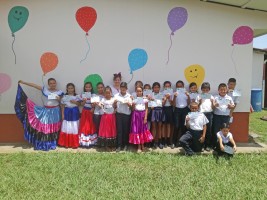
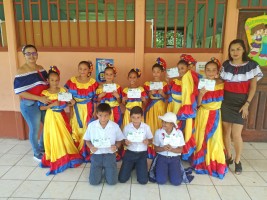
Local schoolchildren proudly displaying their diplomas (Photo: Dr Chris Vaughan)
Dr Chris Vaughan updates us on 26 July 2018, with photographs of local school children receiving diplomas for completing the Scarlet Macaw course, as well as links to nest-box cameras, and a request for further funding for more nest boxes for the 2018/19 season. The school children will be involved in mourning the nest boxes and monitoring the sites.
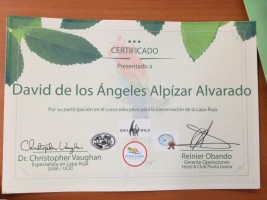
Close-up of sample diploma awarded for completing the Scarlet Macaw awareness course (Photo: Dr Chris Vaughan)
Dr Chris Vaughan adds on 7th August 2018: "Your most recent donation was used to part fund the purchase of this computer server, which is now installed in Punta Leona, where the nest boxes and cameras are. Previously we had to send the signal to San Jose, which mad everything more indirect.The final chick has left the nest and I don't expect new nesting activity to pick up until October ... so we can get ready for an exciting nest season in 2019 with cameras, nests and excellent internet service!"
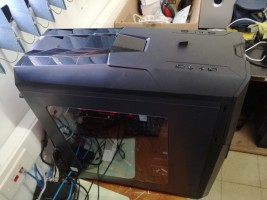
The project's new computer server
Dr Chris Vaughan's update in September 2019 gives the following news-
"I returned from the field and working with scarlet macaws and local human communities two days ago and will include some pictures. The trip involved three themes: a) a presentation on September 10 of 20 rural high students from 5 rural high schools of scarlet macaw counts they made last month; b) on September 11 observing over 50 scarlet macaws in Punta Leona preparing for the reproductive season; and c) on September 11 working with the expoachers who build and place artificial nests and the internet technician on the cameras and checking several artificial and natural nests.
Rural High School Presentation. The high schools are from a region buffer to La Cangreja National Park (several kilometers east of Carara National Park, Carara being the area where the scarlet macaws and our research/management had concentrated since 1990. But with the counts, I am excited to report that the scarlet macaws have started to recolonize the Cangreja area and the students have taken the responsibility to learn about them and protect them. I was in this area several months ago with Humberto Solorzano, a retired teacher who gave our scarlet macaw course for 20 years, giving out coloring books and explaining course methodology to rural school teachers/directors. So with the highschools students, I feel we are covering grade and highschoolers. To my knowledge, it is the first time in Costa Rica and perhaps Latin America that an endangered species is understood and protected in this way. In several weeks, I will visit the high schools with the park guard who began the counts and teach them simple methodologies to gather data on diet, nests, historic and recent distribution, reproduction, and if the scarlet macaws are living year round in the region (subpopulation). I think having these young conservationists involved studying and protecting their scarlet macaw is exciting. We will also give them coloring books because although they are for elementary school children, there is a lot of important information. And finally a diploma in recognition of their work. I have attached several photos of the September 10 event.
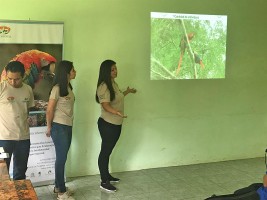
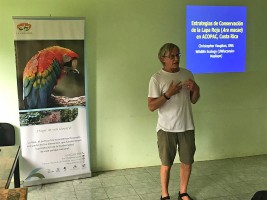
Presentation about the Scarlet Macaw project (Photos: Dr Chris Vaughan)
Nests, Cameras, Reproduction. Several cameras aren't giving signals and we are exploring why before nesting season begins in November. We may change cameras, cables, splitters, camera position, etc. One of our most long-term natural nest has filled with water which we need to fix if possible. Also observed scarlet macaws playing and getting ready for reproduction.
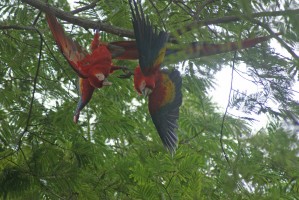
Scarlet Macaws displaying (Photo: Dr Chris Vaughan)
Again I thank The Parrot Society-UK. The scarlet macaw population is increasing and spreading out. We must work on stopping poaching; in their talk, one highschool student angrily told the public that a man showed up near their farm asking to buy wild scarlet macaw chicks and the family angrily sent him on his way. We need that throughout the region. Environmental education is a major step. Little by little."
Dr Chris Vaughan provides a further update in February 2020:-
In August 2019, I returned from my first trip, this year, into a region east of the Carara National Park where we have been studying scarlet macaws for almost three decades. The scarlet macaws had been eliminated in the east but since about 2005 (we are documenting with locals), have been recolonizing, due I think to our in-situ management (habitat, macaw population and humans) efforts. The area we visited was inside and around the La Cangreja National Park; scarlet macaws are being seen there from 500-1000 meters elevation. All the pictures I am sending are from schools we visited, except the scarlet macaws in an artificial nest.
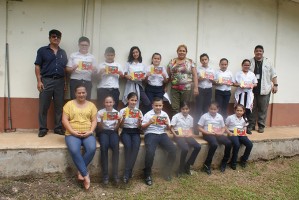
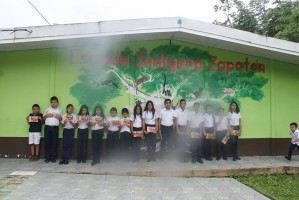
More school groups with their colouring books (Photo: Dr Chris Vaughan)
Both national parks now have the scarlet macaw as their symbol. High-school students have been making August counts over the last two years, thanks to the efforts of my colleague, Leonel Delgado, a very active national parks guard, who accompanied us. Humberto Solorzano, the retired CR rural grade school teacher formed the third of our trio. Humberto gave the course between 1995-2017 at the lowland Quebrada Ganado Elementary School and was co-author in an environmental education article in English. Humberto explained the course methodology to the teachers and we gave colouring books to students in all the schools; teachers and students say they frequently observe scarlet macaws. Punta Leona, who had helped fund the scarlet macaw project since 1995, has reduced their aid due to the financial crisis, especially for colouring books, the website, cameras and artificial nest boxes (built and placed by my ex-poacher friend). Therefore, I am turning to The Parrot Society-UK to request more assistance. (Editor’s Note. The Parrot Society UK provided the $2,500 requested and the scarlet macaw project continues to flourish. US$2,500 would be spent for the following items:
Scarlet Macaw Colouring Books. We need to continue to provide colouring books to school children because as the scarlet macaw extends its distribution, we want to cover the schools where it is now found. We have visited and provided colouring books ($3/book) to over 300 students in 18 schools, but now need to extend to 7-8 more schools, as well as provide colouring books to the new fourth graders. We give books to fourth grade teachers/students in larger schools, 4-6th grade teachers in smaller schools and even all grades in schools with only one teacher and 6-7 students so they won't feel left out. We visited several indigenous grade schools, inside an indigenous reserve, (Zapaton) next to La Cangreja National Park. Punta Leona has said they will include the 4 schools they have covered since 1996, but no more.
Artificial Nests. There are 9 artificial nests in Punta Leona, scarlet macaws have visited all of them and nested in at least four of them. I am sure the number will increase in 2020 as several were placed in 2019. However, I am interested in continuing to provide local communities, especially schools, as well as the two national parks (Carara and La Cangreja) with artificial nests so they can protect, observe and feel proud of them. Their cost is approximately $180/nest and its placement. They are built and placed by the most famous scarlet macaw poacher in the area and it allows him an alternative income source.
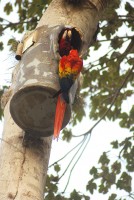
Pair of Scarlet macaws at an artificial nest box (photo: Dr Chris Vaughan)
Scarlet Macaw Web site and Live Cam of Reproductive Season. Between 2015-2018, with your help, we have worked to construct a scarlet macaw website and livecam for the scarlet macaws nesting in Punta Leona (Scarlet macaw nest cams). We have included videos constructed around the 2016, 2017 nesting seasons (reproduction, nest competition, predation, nest and camera placement) and in 2017 had over 12,000 hits from 52 countries. Also several grade schools in the region, including the Quebrada Ganado Elementary School with Humberto Solorzano in charge, give courses around the January-July nesting seasons or using videos when it wasn't possible. However, the website and live cam have not kept up with our needs, and the computer engineer decided he couldn't continue in 2018, I think largely because we couldn't pay him. With approximately $100/month, he will return to and greatly improve the web site and live cam, which I believe would be used by many of the several thousand grade schools/high schools in Costa Rica with internet, including those with scarlet macaws in our Central Pacific and the Osa Peninsula. We will need funds to purchase and improve the camera system in Punta Leona. They will provide the security, internet and electricity.
I believe that with the $2,500 I am requesting, we can move ahead. I am requesting $1,500 from another funding source. Also it is important that you realize that scarlet macaw poaching has begun again in our region and over 20 scarlet macaw nests were taken from Guacalillo Mangrove Reserve and the 20-30 chicks sold (we don't know to whom). We are working with this with the CR Wildlife Office and local park guards, but feel that the local community will always be one of the major forces to stop this terrible threat on the scarlet macaw community. Environmental education is one of our only tools.
A big thank you to Exotic Direct Pet Insurance for helping us to sponsor this project - Parrot Insurance
Dr Vaughan's latest update in January 2021 is as follows:
Our rural school environmental education program has been on hold because Costa Rican schools are closed. We have many coloring books, but are looking for ways to get them in teachers/students hands. Also some teachers receive the link to our video cameras in nests.
So most work has focused on 12 artificial nests in Punta Leona and 5 video cameras. Most nests are occupied by scarlet macaws, but we are unsure if they will all nest successfully. At least wildlife seems to be alright with Covid, except where local hunters without work have invaded wildlands for game.
I am sending you the link to our active cameras in 4 nests. Three have eggs and I have approximate dates they were laid. In the Ceiba#1, a chick should hatch in late January. Hope to have the fifth camera functioning by January 22 (soon after Trump leaves office!!). The link should work it is on 24/7, but has occasional problems. http://186.176.227.5:8080/
We now have a further update published to this site in July 2021:
Report to The Parrot Society-UK on the Central Pacific Scarlet Macaw Project. Costa Rica. 2021
Christopher Vaughan, Honorary Associate, Department of Forest and Wildlife Ecology, University of Wisconsin-Madison, Madison, Wisconsin & International Institute for Wildlife Conservation and Management, Universidad Nacional, Heredia, Costa Rica
Introduction
This report is divided into six sections: a) Artificial Nests, b) Video Cameras, c) Environmental Education, d) Use of PSUK Funds, e) Photos Taken in February 2021, f) Final Comments, and g) Literature Cited. It will cover the June 8, (2020) to February 15 (2021) period.
Artificial Nests
Since 1995, we have constructed about 45 scarlet macaw artificial nests with different levels of nesting success and longevity. They have been made from: a) several types of wood, b) 50-gallon plastic barrels, c) 14-inch water/sewage tubes, and d) fiberglass (Vaughan, C., F. Dear, N. Nemeth & L. Marineros. 2006; Vaughan, Nemeth & Marineros, 2003). The artificial nests were placed in several areas: a) Carara National Park, b) the Hernan Vargas Cattle Ranch (in front of Carara National Park), c) in local towns near rural schools, and d) the Punta Leona Hotel and Reserve. Beginning around 2010, we worked almost exclusively in Punta Leona for several reasons: a) high nest security, b) high scarlet macaw nest use, c) proximity to electricity/internet for future video cameras, d) two Punta Leona internet technicians who collaborated, e) Punta Leona field-workers providing their important scarlet macaw observations when questioned, f) experimentation permitted, including chainsawing a nest in a dead tree (Vaughan, 2018), g) lodging, h) over half Punta Leona’s 100+ hectares found in a forest reserve with large adjacent forested areas- all scarlet macaw habitat, and i) total cooperation from Punta Leona on other scarlet macaw themes since 1995 (environmental education with workers, rural schools, towns; La Leona bimonthly magazine’s scarlet macaw articles (Vargas, 2019), transportation if needed, etc). Most Punta Leona employees came from local communities and were important messengers and defenders on scarlet macaw conservation in their towns. Working with Punta Leona provided us with a vast amount of valuable scientific and extension information for use in other Central Pacific sites. We knew the Central Pacific scarlet macaw nests asynchronously between December and July (see below under Video Camera), which was important information for preparing nests, cameras and protection programs (Vaughan, Nemeth & Marineros, 2003). The other sites proved: a) more insecure, b) more difficult for access/research/extension, c) with a lack of constant electricity/internet for video cameras and d) more difficult for lodging/food. On a limited budget and human resources, I wanted to combine nesting success with video cameras which showed nesting to the public; this was a major factor in the decision to choose Punta Leona as our key research site. I have returned on occasion (and will continue to do so) to local towns and rural schools to place nest boxes with mixed results.
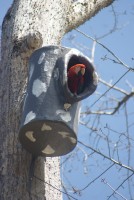
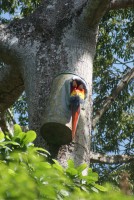
Macaws at artificial nest boxes
On this note, since 2016, 17 artificial fiber glass frame scarlet macaw nests have been designed and constructed by Wilbert Vargas (famous former scarlet macaw poacher) and his son Enrique, based on their knowledge of natural scarlet macaw nests and the macaw’s needs for nesting. After building, they placed them in the trees. Thus building, placing and caring for these nests has provided an important income for these two men and helped changed their attitudes from scarlet macaw poachers to conservationists (I hope!). Wilbert has been interviewed on television, radio, appeared in the newspaper and given lectures in a scarlet macaw workshop I organized at the University of Costa Rica. Five nests were placed in or near local rural schools and the town of Tarcoles with Enrique and Wilbert the heroes in the eyes of the students. Unfortunately none of these five attracted scarlet macaws, one at a school had an Africanized bee’s nest and had to be removed by the local firemen. Eventually all fell or failed.
The remaining 12 were placed in Punta Leona Hotel and Reserve. Over time, most in Punta Leona have been lowered, cleaned, reconstructed, and replaced so we can observe their use by scarlet macaws and other species. They have proved successful in many ways. As of Februry (2021), ten (10) of the twelve (12) Punta Leona artificial macaw nests have been occupied by scarlet macaws; the eleventh has a bat falcon (Falco rufigularis) and the twelfth, located closer to the hotel’s reception area, has not received scarlet macaws. Although presently (February 22) occupied by scarlet macaws, we are unsure how many artificial nests will produce fledglings. We only have 5 video cameras (see below) and no regular climbing person to document these nests. In addition, we have seen the Bare-throated Tiger Heron (Tigrisoma mexicanum) sitting atop one of our nests and nesting in the same tree where artificial nests were placed. We are worried that some disappearing scarlet macaw eggs are being caused by its predation on them, but the video cameras are showing more nesting success in recent weeks. In past years, we have observed other egg or chick predators including the Keel-billed Toucan (Ramphastos sulfuratus), or nest competitors, such as the Keel-billed Toucan, the Mexican Porcupine (Coendou mexicanus), the kinkajou (Potus flavus), Black spiny-tailed Iguana (Ctenosaur similis) and other scarlet macaws (Vaughan, 2019). The smooth sided fiber glass nest boxes aid in ensuring most mammals and the lizard cannot enter the nests. Most of these nest predators and competitors can be observed in videos on our web site, seen by clicking on http://186.176.227.5:8080 or “Nidos en Vivo Punta Leona”, then Live Macaws Camera under QUICK LINKS. You can also observe the nesting scarlet macaws, discussed in the next section.
There are other species, including the Black-bellied Whistling Duck (Dendrocyna autumnalis), and the Barn Owl (Tyto alba) which use the artificial nests at other times of the year. The Africanized bee has been a problem since the middle 1990’s (I know because I was once a Costa Rican bee keeper), but with a light chemical for chickens, it has been repelled. We move ahead with our nest management.
Video Cameras
Because the Central Pacific scarlet macaw nesting season (egg laying, chick growing to fledging) is asynchronous by pair and lasts between approximately December and July, one must have equipment (nest, cameras, internet, etc.) ready. We have observed that scarlet macaw pairs will actually compete for and try to claim nests in October or before with other species.
Between 2016-2020, mostly with PSUK funding, we experimented with three video camera types in 4 natural nests and 5 artificial nests in Punta Leona with mixed success. However, the natural nests were destroyed either by the tree dying and falling or the nest rotting in a living tree.
This year (2021), we placed an artificial nest over the natural nest in the living Guayabon tree and scarlet macaws are now nesting in it! The five cameras for the 2021 scarlet macaw reproductive season are placed in artificial nests, all located 50-150 meters from the computer center where the Thermaltake Server and WD 6TB MyCloud Mirror are placed to provide electricity and internet and receive the cables from the nests with cameras. Although under a tropical climate, the computer room is air conditioned, but sometimes slightly humid. In 2017, using video cameras in four nests, we had several thousand “hits” from interested people in over 50 countries watch the Punta Leona scarlet macaws attempting to reproduce.
It has been five years of trial and error with video cameras, artificial nests, electricity/internet ups/downs, and my human team to arrive at our results. Even with problems faced, I am satisfied with the video camera’s evolution because thousands of people worldwide can observe the scarlet macaw nesting cycle (when the system functions). As I mentioned above, click on http://186.176.227.5:8080 or “Nidos en Vivo Punta Leona”, then Live Macaws Camera under QUICK LINK to observe the five nests. Although all nests may have scarlet macaw adults inside at any one time, four have either chicks or eggs. On Saturday (February 20), I finally got my team together to fix the cables and camera of nest Ceiba#3 so the 30+ day chick became visible to the public. A climb two weeks earlier showed the individual chicks’ existence, but the technician said after the climber left that the cable from his office to the Ceiba#3 nest had to be changed. I climbed to work on nests until I was 60, but my wife and I agreed I would leave climbing if she stopped her occasional smoke!! We have both complied up to now! I have documented the approximate date eggs were laid in each of the four nests, when chick hatched or should hatch and approximately when they will fledge if they survive.
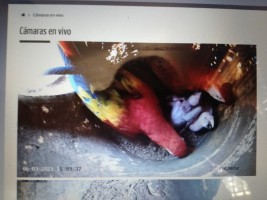
Still photo from nest cam - 2 adults with 2 chicks
Presently I have placed six other artificial nest boxes with scarlet macaws entering within 100 meters of either the computer center or another electricity and internet source. My plan is to add future cameras (up to eleven!) to these nests as part of the Scarlet Macaw Project. Their success would generate much information, permit the public (especially school children) to follow a minimum quanity of successful nests if some cameras are down or macaws fail and provide for a new variety of research and extension projects; I have several in mind with colleagues who have worked with macaws.
Environmental Education
Our rural school environmental education program has been paralyzed because Covid closed Costa Rican schools in 2020. We have several hundred coloring books waiting to be distributed, but entrance into the classroom has been cautious (as in most countries). I am working with Humberto Solorzano, considered the outstanding Central Pacific Scarlet Macaw Teacher because of his fame in loving, working to conserve and teaching about scarlet macaws. Scarlet macaws have extended their range and are now found outside his house! Humberto taught fourth graders about scarlet macaws in the Quebrada Ganado school continuously between about 1997 and 2016 when he retired. He still knows most teachers in the region and uses telephone calls, internet to maintain contact in these Covid times. We plan to reconnect with most as schools begin to reopen this month. We have visited many schools together in the past to leave scarlet macaw coloring books, talk about the video cameras and give short lectures to teachers and students.
Use of PSUK Funds
The $2,400 was used since its arrival on June 8 (2020) as follows: a) 75% in the artificial nests construction, reconstruction, placement, removal, replacement. Funds have also been used for cameras, camera equipment and working with cameras in the nests, b) 15% in counting scarlet macaws after the nesting season to track their numbers (had been on hold for several years), c) 5% in a video and the website and d) 5% on food and gasoline. Although it wasn’t used exactly as proposed, I think we adapted to the situation. I hope that the P-UK continues to finance this project, although I understand Covid has taken a huge toll on the UK (as in the US and elsewhere) and your organisation. I hope all are safe.
Final Comments
Problems surfaced to make the nest box and video camera projects work in 2020. The artificial nest box part of the project has been the most successful. I am working on employing a second climber, tried one, but it was complicated. Enrique continues to be preferred for numerous reasons (poacher father, experience, interest). Much of 2020’s problems were mainly due to Covid, but there was also: a) our climber’s illnesses and work with scarlet macaws as an “extra”, b) internet/electricity didn’t function at times, and c) cameras and camera equipment needing fixing/changing/refixing to name a few. But we have advanced.
The rural school environmental education was a disappointment due to Covid causing schools to close entirely. But 2021 looms ahead and there is interest from the rural school teachers to continue using the coloring books and internet/video cameras filming living the scarlet macaw reproductive season, now in progress.
I believe this project using artificial nests, video cameras, environmental education books and internet has been highly successful in the Central Pacific and is helping the scarlet macaw population to recover and expand. It has become a showcase of a successful neotropical endangered wildlife project. And the Central Pacific scarlet macaw peacefully coexists with man to boot (but see end)!
One of our next research projects will be to quantify Central Pacific scarlet macaw population size (justifying the counts) and their distribution. As part of his M.S. thesis, in 1992, my former graduate student interviewed 395 people throughout the Central Pacific about scarlet macaw distribution (Marineros & Vaughan, 1995). Preliminary data in 2020 indicates this distribution has doubled, but we need to carry out more interviews.
We must also conduct more scarlet macaw population counts (Vaughan, C., N. Nemeth, J. Cary & S. Temple. 2005) because in the last decade when the few counts were taken indicate it has also doubled. This has probably led to scarlet macaw saturation of the area around Carara National Park and Guacilillo Mangrove Reserve, the mangrove being the major scarlet macaw nocturnal roosting site at least since 1990 when we began studies in the area. Without scientific confirmation, I believe they have formed subpopulations and are probably occupying its former range in the Central Pacific. This next stage is more difficult and time consuming and will require population counts, distribution interviews, genetics and analysis and publication of results.
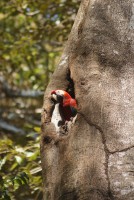
Scarlet Macaw at natural nest site
Once shown, as an expert who works with Peruvian macaws and I discussed, the Central Pacific scarlet macaw population will be one of only three of the world’s macaw populations which has increased in size and distribution. Initially I will probably be satisfied to show the increase in distribution. And the Central Pacific is in a mixture of native forest and agricultural and village/town environments!! Also I feel that the resident human population of the Central Pacific is partially responsible because they have learned to understand the importance of the scarlet macaw for economic, ecological and cultural reasons. Conversing with them, they lead me to understand that the scarlet macaws are theirs and they defend them, which is poetic and beautiful at the same time.
In general, wildlife, such as the scarlet macaw, seems to prosper with the presence of Covid, except where jobless local hunters have exploited wildlife as a food source and for other uses. Former poachers, who are now friends, tell me that scarlet macaw poaching continues in the Guacilillo Mangrove Reserve and local park guards seem powerless to stop this. There is still a market of buyers which is very bad. I am unsure where this will lead. But we must continue to try
These research, extension/environmental education projects exist greatly because of The Parrot Society-UK’s continuous support. The scarlet macaws and humans from the Central Pacific who have grown to protect and love their birds thank you. I am at your disposition to answer any questions.
And I have not even broached the theme of climate change descending on the planet and how it seems to be affecting scarlet macaw reproductive cycle. But enough is enough.
In December 2021, Dr Vaughan adds the following comments:
"Thanks to our work, with your support, it is common to see scarlet macaws feeding close to humans and their homes in many towns like Tarcoles, Quebrada Ganado, Punta Leona (and others) in the Central Pacific where we have studied them since 1990. It's an example of endangered scarlet macaws coexisting with humans!! If wild parrots are treated well, I am sure many species would coexist with humans." He adds - "At the study site today I noticed scarlet macaws nonchalantly feeding several metres above humans, who were excitedly taking pictures of them. This co-existence didn't occur a decade ago".
Then in July 2022, Dr Vaughan sent these two pictures:
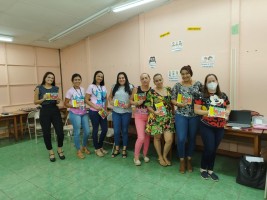
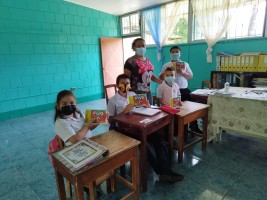
The first showing eight elementary school teachers in an area where scarlet macaws have only recently been observed; and the second shows four students and their teacher at a very small rural school. Both pictures show the colouring books in use.
On 7th October 2022, we have further good news:
"Thirty high-school students and their professors got together to present their results of their macaw counts, in rural central regions where these birds did not exist a decade ago!" Dr Vaughan gave a presentation on the project, and distributed diplomas to each student, and was in turn presented with a macaw statue, made by the students in recognition of his years of dedication to the project.
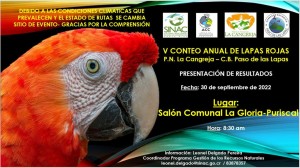
Poster announcing the presentation
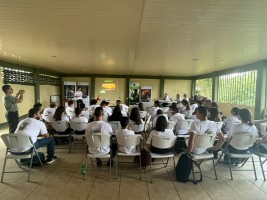
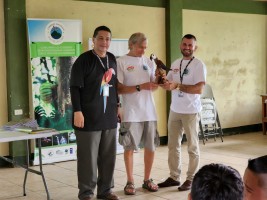
Students at the presentation; and Dr Chris Vaughan (centre) receiving his statue
This report was followed by photographs from the field of the counting of scarlet macaws in mangrove swamps. 42 young birds were seen in one morning alone! Memo Hernandez (pictured) has been counting macaws since 1990!
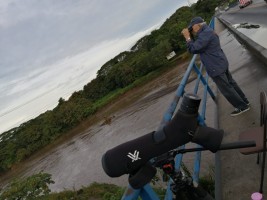
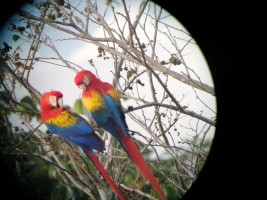
Memo Hernandez on Tarcoles bridge; pair of macaws seen through his telescope.
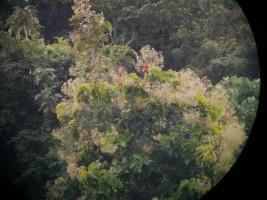
Pair of scarlet macaws re-colonising the area
Further funding of $3,400 was agreed in March 2023, to cover distribution costs of more colouring books to local schools, and Dr Vaughan sent us this response - "Wonderful news. Your donation has arrived! Based on the donation, I just paid Humberto Solorzano for his work. We will deliver coloring books and information related to the two courses (#1 coloring books, #2 cameras/nests-reproductive cycle) this Friday to 7-8 rural grade schools where scarlet macaws are found. Next week we hope Humberto can deliver books to another 20+ grade schools before Easter starts. Work with schools once courses begin (checkups) will often be carried out only by Humberto, but this time I will accompany him and leave him the 1000 books in 5 boxes next to me in San Jose. Also, Humberto has 150 in his custody, but we will use those needed at each school and the books will be used for third, fourth and fifth grades. I plan to send you pictures based on our trip.
Anyway, wanted to let you know that the funds have arrived.
Thanks from the scarlet macaws, schoolteachers and their students and me. You are helping in ensuring the scarlet macaws' conservation by educating the youth who then educate their parents and neighbors."
August 2023 The Central Pacific scarlet macaw project continues and there will be a scarlet macaw monitoring short course August 16-17 in Punta Leona organized by Leonel Delgado, a CR park guard who works in La Cangreja National Park. It will deal with taking and processing scarlet macaw count data taken yearly since 2017 by high school students and teachers from 10 rural technical high schools in the Parque Nacional La Cangreja region. One student and one teacher involved in the counts were selected and will attend from each of the 10 high schools. It’s a first and should be very exciting; usually this event is a meeting for part of a day and students present results with little discussion. Finally getting to older students, since we have focused for decades on grade schools in the region. My team had never really worked in the La Cangreja region because it wasnt until about 2001 when scarlet macaws began to appear, and we have always focused on the lowlands near the Tarcoles River-Carara National Park-Punta Leona and have always been short on resources to overextend except with scarlet macaw education at rural gradeschools and trying to map out distribution which has quadrupled since 1993. Just wanted to give you an update on this event as it is developing and will send photos. It’s very important to have high schools (teachers and students) interested in conservation and Leonel has done it.
I have been invited to give a talk on August 16 on the history of our project, its present status and future. Then on August 17, my team and I will show the artificial nest boxes and explain how we worked 5 years to get a functional camera system working. Now we are able to connect to internet and netcam so the Central Pacific rural community, especially the schools, can observe the scarlet macaw reproductive cycle. Of course, worldwide the reproductive cycle can be observed as you have seen. I am expecting technical questions from these high schoolers, so Luis Sanchez, the computer technician from Punta Leona who has been involved with us since the beginning, will be present. Also, Wilbert Vargas, the ex-macaw poacher who now builds our artificial nests, will explain his work with a nest on the ground.
I am very interested in getting this group to take data on diet throughout the year, pinpoint natural nests (although Leonel has found 14), document the nesting cycle (is it like our data in the lowland), and in general understand the scarlet macaw which lives with them more. Perhaps we will agree to an interview like we did in 2005 in the Osa Peninsula with the other national viable scarlet macaw population. Much remains to be seen and I am excited about getting these future conservationists involved, especially since they are all in rural areas coexisting with the scarlet macaw.
Just wanting to update you. We continue to work with rural grade schools and scarlet macaws will soon begin to squabble over nests for the December-June nesting season. This year I will be working again with the scarlet macaw reproductive season in the artificial nests as well as education with schools, The Macaw Society will be somewhere else...
27th January 2024, Chris Vaughan writes -
Literature Cited:
Marineros, L. & C. Vaughan. 1995. Scarlet macaws of Carara. Pages 445-467. In J. Abramson, B. Speer & J. Thomsen (eds.). The large macaws: Their care, breeding and conservation. Raintree Publications, California
Vargas, C. 2019. Programa de conservación de lapas cumple 25 años. La Leona, Punta Leona. Costa Rica. P 20-22
Vaughan, C. 2019. Conservación de la lapa roja (Ara macao) con manejo in situ en el Pacífico Central de Costa Rica. Revista de Ciencias Ambientales. Vol 53(2): 97-110.
Vaughan, C. 2018. Scarlet macaw news in Costa Rica. The Magazine of The Parrot Society-UK. Vol. 52:28-29.
Vaughan, C., F. Dear, N. Nemeth & L. Marineros. 2006. Nest cavities for the scarlet macaw (Ara macao) in Costa Rica and management implications. Mesoamericana 10(2):34-41
Vaughan, C., N. Nemeth, J. Cary & S. Temple. 2005. Response of a Scarlet Macaw (Ara macao) population to conservation measures. Birdlife International 15: 119-130
Vaughan, C., N. Nemeth & L. Marineros. 2003. Ecology and management of natural and artificial Scarlet Macaw (Ara macao) nest cavities in Costa Rica. Ornit. Neotrop. 14: 381-396
